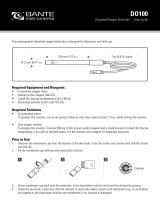Omega DOH-10-Series_DO_Meter Owner's manual
- Category
- Measuring, testing & control
- Type
- Owner's manual
This manual is also suitable for
Omega DOH-10-Series_DO_Meter is a professional-looking portable meter with a large LCD display. It is designed with a BNC connector compatible with any DO galvanic electrode. The meter has a hold function, power capacity icon indicator, and automatic power-off in 15 minutes (which can be disabled). It also includes an RFS (Recover to Factory Setting) function. With built-in different temperature compensation selectable (Thermistor 30K, 10K ohm, and manual 25.
Omega DOH-10-Series_DO_Meter is a professional-looking portable meter with a large LCD display. It is designed with a BNC connector compatible with any DO galvanic electrode. The meter has a hold function, power capacity icon indicator, and automatic power-off in 15 minutes (which can be disabled). It also includes an RFS (Recover to Factory Setting) function. With built-in different temperature compensation selectable (Thermistor 30K, 10K ohm, and manual 25.
















-
 1
1
-
 2
2
-
 3
3
-
 4
4
-
 5
5
-
 6
6
-
 7
7
-
 8
8
-
 9
9
-
 10
10
-
 11
11
-
 12
12
-
 13
13
-
 14
14
-
 15
15
-
 16
16
Omega DOH-10-Series_DO_Meter Owner's manual
- Category
- Measuring, testing & control
- Type
- Owner's manual
- This manual is also suitable for
Omega DOH-10-Series_DO_Meter is a professional-looking portable meter with a large LCD display. It is designed with a BNC connector compatible with any DO galvanic electrode. The meter has a hold function, power capacity icon indicator, and automatic power-off in 15 minutes (which can be disabled). It also includes an RFS (Recover to Factory Setting) function. With built-in different temperature compensation selectable (Thermistor 30K, 10K ohm, and manual 25.
Ask a question and I''ll find the answer in the document
Finding information in a document is now easier with AI
Related papers
Other documents
-
 Bante Instruments 810 Benchtop Dissolved Oxygen Meter Owner's manual
Bante Instruments 810 Benchtop Dissolved Oxygen Meter Owner's manual
-
Apera Instruments SX716 User manual
-
 Bante Instruments IE-80T Industrial Dissolved Oxygen Electrode Owner's manual
Bante Instruments IE-80T Industrial Dissolved Oxygen Electrode Owner's manual
-
BANTE 820 User manual
-
 Bante Instruments DOscan10 Pocket Dissolved Oxygen Tester Owner's manual
Bante Instruments DOscan10 Pocket Dissolved Oxygen Tester Owner's manual
-
CMA BT78i User guide
-
CMA ML66m User guide
-
 Aquasol Digital AM-DO-01 User manual
Aquasol Digital AM-DO-01 User manual
-
FlePow 8541833494 User guide
-
 Bante Instruments Dissolved Oxygen Electrode Owner's manual
Bante Instruments Dissolved Oxygen Electrode Owner's manual




















